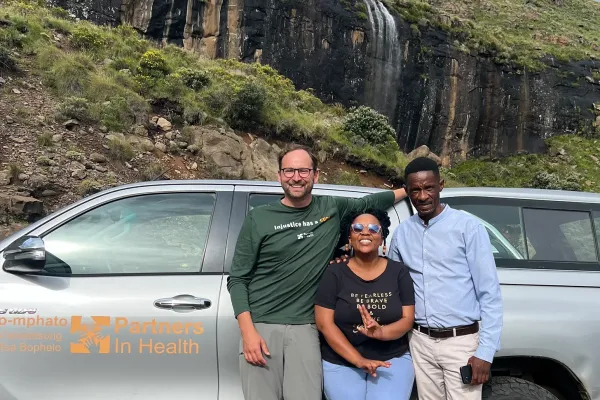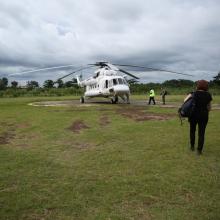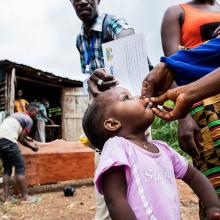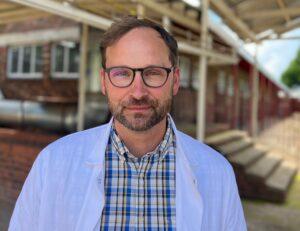
Normally based in Saskatoon, PIH Canada Board member Dr. Ryan Meili is a family physician and lifelong advocate for healthy public policy with a focus on health equity. In the article series “A View from Lesotho,” Dr. Meili will be sharing his thoughts and experiences from Lesotho, where he is currently serving as a clinical volunteer with Partners In Health, based in Maseru at Botšabelo Hospital, along with his wife Mahli, a pediatrician.
Courtesy of Ryan Meili
Lesotho is as African as can be but, as one our colleagues likes to remind us when our differential diagnosis includes strange parasites, it is not a tropical country. There are no anopheles mosquitoes to give you malaria. There are no hippos, lions or crocodiles. The streets are safer than anywhere else I’ve been on the continent, unless you play Famo in Mafeteng. But the continent’s, and the world’s, most dangerous creature, who goes by the name of Mycobacterium tuberculosis, is here in force and it too can take your breath away.
For two years, TB lost its title as the deadliest global infectious disease to another respiratory killer. Nearly 2 million people died from COVID-19 in 2020, 3.5 million in 2021. Thanks to widespread vaccination and changes in the virus, that total dropped to 1.2 million and just over 200,000 in 2023. Of course, all of those annual totals are estimates, with different reasons for limited testing at different phases. Still, they track an astounding tale of a novel contagion appearing out of the blue and a worldwide effort to get it under control.
Having moved from working and writing on COVID to treating tuberculosis, it was impossible not to see the similarities and syndemicities between these airborne menaces. During the peak of the pandemic, TB diagnoses dropped dramatically. 7.1 million cases were diagnosed in 2019, only 5.8 million in 2020 and 6.4 million in 2021. In Lesotho, the diagnosis rates dropped to 65% of pre-COVID rates, the second highest drop in the world after the Philippines. Great news, right? Not so much. The cases hadn’t stopped, they just weren’t being found. Not being found, they weren’t being treated, the bacteria was spreading further and taking more lives in the process.
COVID had diverted the attention of public health departments and clinical services away from regular surveillance and treatment of many conditions. It was all COVID all the time and all other services suffered, as did funding. For example, global spending on TB dropped from $6 billion USD in 19 to $5.4 billion in 21, a far cry from the $13 billion per year that the World Health Organization said was needed by 2022.
The attention of the health system wasn’t the only thing that was elsewhere. People were staying home. They weren’t going to clinics, meaning there were fewer opportunities to identify and treat TB early. And while the use of masks and decreased social circles may have limited some of the opportunities for transmission, there were other ways for TB to spread.
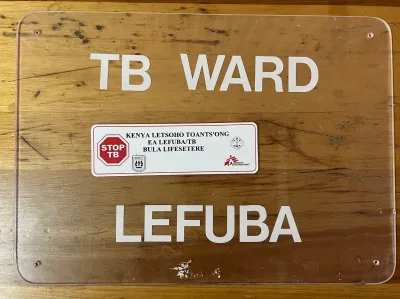
Ryan Meili / Partners In Health Canada
Some studies indicate that each of these two illnesses can increase the severity of the other one. It also follows that more coughing from one could mean more spread of the other when people were in public places. Also, unlike COVID which can be transmitted with a very brief interaction, TB tends to require a longer exposure. With people staying home and staying indoors, there was more chance for them to share TB within their bubble. This especially applies to places like Northern Saskatchewan where crowded housing is one of the major reasons TB persists in a place like Canada where we imagine it to be something from long ago and far away.
In Saskatchewan, the rate of new TB cases in Saskatchewan doubled from 2019 to 2021. We saw outbreaks in Northern on-reserve communities, hospitalizations and even deaths. Worldwide, the number of deaths increased to 1.6 million in 2021 from 1.2 million in 2019, a 33% increase. This was above 2015 levels, notable in the Sustainable Development Goal for TB is a reduction in deaths from 2015 levels by 90% by 2035, with the clearly missed interim goal of a 35% reduction by 2020.
Excess deaths due to TB during the pandemic compared to baseline. Source: World Health Organization.
The good news is that those gains appear to be returning, as the number of deaths in 2023 has returned to 2019 levels. The trend remains far off of the 2035 goals but there is cause for hope and the experience with COVID can inform our efforts to fight TB.
“If the pandemic taught us anything, it’s that with solidarity, determination, innovation and the equitable use of tools, we can overcome severe health threats. Let’s apply those lessons to tuberculosis. It is time to put a stop to this long-time killer. Working together, we can end TB.” Dr Tedros Adhanom Ghebreyesus, WHO Director-General.
Breathing Life
Among those signs for hope are that, despite the efforts of some to undermine public confidence in vaccination, the COVID-19 vaccines were a resounding success. It is a scientific miracle that we went from a new deadly pathogen to multiple safe, effective vaccines within a year, a medical moonshot. It’s hard to imagine the syndemic story we’d be telling today without it. This success has reinvigorated interest and investment in vaccines for other conditions. A new malaria vaccine is being rolled out in Cameroon and eight other African nations this year. And the first new TB vaccine in 100 years is being tested in multiple countries.
Another sign of hope is a new approach to strengthening health systems in low income countries. Prior to COVID, Lesotho was entirely dependent on oxygen from South Africa. When the virus hit South Africa hard, they stopped shipping oxygen to other countries. This left Basotho patients without this basic lifesaving treatment during a respiratory outbreak. Partners In Health recognized that the need for independent oxygen production wasn’t just about COVID but all of the overlapping respiratory conditions their patients faced. PIH teamed up with the Lesotho Ministry of Health to build the country’s first oxygen plant at the Botšabelo MDR-TB Hospital. This project now provides oxygen to health facilities across the country and PIH has expanded this BRING O2 model to four other countries, providing safe, reliable, and quality oxygen in Malawi, Rwanda, Peru, and Madagascar.
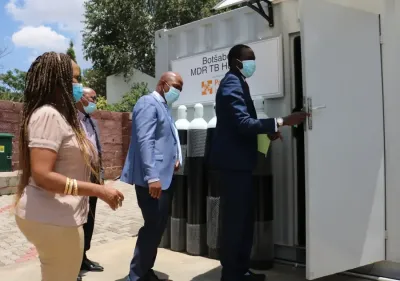
Dr. Melino Ndayizigiye, executive director of PIH in Lesotho tours dignitaries from the Lesotho Ministry of Health through the new oxygen facility in 2020.
Mpho Marole / Partners In Health
There are many things we can learn from the COVID-TB syndemic, some lessons in what not to do, others great achievements to build on. What is clear is that the existence of high burdens of disease every year make us more vulnerable to new pathogens in extraordinary times. Preventing and curing more of the illnesses we have now (including Non-Communicable Diseases like hypertension and diabetes) makes us less vulnerable to new health problems. Understanding how different illnesses build on each other to cause greater harm to individuals and communities will help us to better address the root causes of ill health. Decoupling the destructive power of syndemics would be a breath of fresh air.
One final note, in their article COVID-19 and tuberculosis: the double whammy of respiratory pathogens,“ Shariq et al. point out how “both these respiratory infections feed on social inequality.” More on this next week in Syndemicity III: Murder By Numbers.
